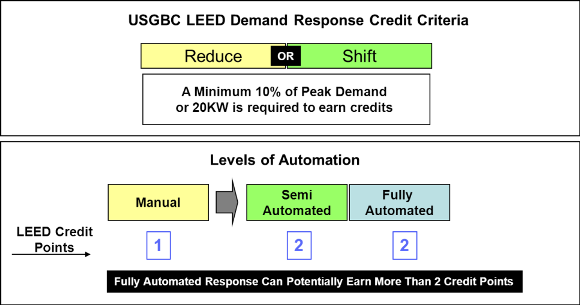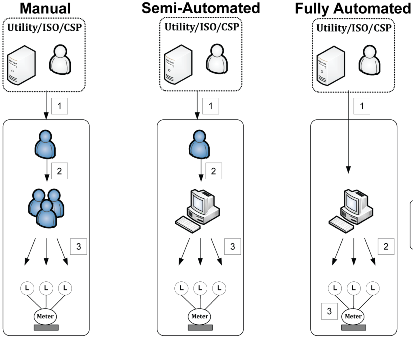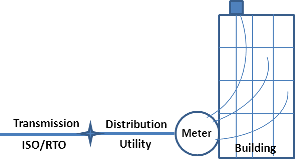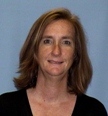
Source: USGBC
|
October 2011 |
[an error occurred while processing this directive] |
|
Demand Response for Commercial Buildings is
Coming of Age |
| Articles |
| Interviews |
| Releases |
| New Products |
| Reviews |
| [an error occurred while processing this directive] |
| Editorial |
| Events |
| Sponsors |
| Site Search |
| Newsletters |
| [an error occurred while processing this directive] |
| Archives |
| Past Issues |
| Home |
| Editors |
| eDucation |
| [an error occurred while processing this directive] |
| Training |
| Links |
| Software |
| Subscribe |
| [an error occurred while processing this directive] |
One could
argue that this past summer demand response helped save the
grid from rolling blackouts in several regions of the country. The
ability by grid operators to call on commercial and industrial
customers to reduce power consumption during peak hours has been a
win-win for both the grid and the customers.
For customers, they not only save on the electric bill by reducing
usage, they get paid additional amounts based on how much they reduce
during demand response events. Demand response isn’t new; it has been a
fast growing subsector of the electric market for the past several
years. The early adopters tended to be industrial customers with
significant load. The commercial building sector is now hurrying to
catch up and cash in on demand response opportunities.
A succession of important events and activities has occurred this year
that will help propel the widespread adoption of demand response by the
commercial sector. Each event or activity addresses key barriers to
commercial building participation. When viewed as a whole, these events
and activities make a compelling case for the building community.
The first key event addresses the economic barrier to commercial
building participation. In March 2011 the Federal Energy Regulatory
Commission (FERC) passed Order 745. FERC Order 745 is a victory for customers who participate in
demand response programs. In a nutshell, Order 745 mandates that load
shed by customers during demand response events has the same market
value as generation does. This is significant because generation sold
into wholesale markets can be worth 10 times more than a customer pays
for it during peak demand hours. As a result, a building responding to
a demand response event not only lowers the electric bill, but has the
opportunity to get paid additional monies.
The second key event addresses the confusion regarding how to implement
demand response. In June 2011, the U.S. Green Building Council (USGBC)
released a comprehensive LEED Demand Response Pilot Credit .
USGBC’s Demand
Response Pilot Credit establishes an implementation roadmap with
documentation and reference materials that enable any building to
participate in demand response programs.

Source: USGBC
The three demand response implementation methods defined by USGBC
include: Manual, Semi-Automatic and Automatic. LEED projects can
satisfy the demand response credit requirements by demonstrating their
ability to shift energy consumption during peak events by 10 percent of
peak load demand, or a minimum of 20 kW. USGBC has weighted the three
methods to award more points for the Semi and Automatic implementation
approaches.

The
third key activity addresses where to find qualified demand
response programs and who to call on for assistance. In July 2012
the National DR Directory was launched. Compiled in the National DR Directory
are reports on over 1,300 demand response programs across the
U.S. Searchable by state, utility and program provider, this
information tool enables commercial building energy managers to find
and learn about demand response programs that in their markets.
In addition, the National DR Directory has listings of service
providers that specialize in working with buildings on demand response.

Source: National DR Directory
The fourth key activity addresses the technology required to manage and
optimize demand response opportunities for commercial buildings. There
are two important sides of the technology equation required to truly
make demand response work. The easiest way to differentiate between the
two sides is to view them as being either behind the meter and in the
building or from the meter to the market.

From the meter to the market, several technologies-related initiatives
will impact buildings, utilities and wholesale market operations. There
is currently a rush by utilities to install new smart meters that
measure consumption in 5 to 15 minute increments as well as providing
two way communications between utilities and buildings. The meter
installation push has been greatly assisted by the $3.4 billion dollars
provided by the Department of Energy Smart Grid Investment Grant
program. In addition, new technologies addressing substation
automation, demand response transaction processing and automation of
demand response event management have been gaining rapid adoption by
utilities and wholesale market operators.
[an error occurred while processing this directive]The large building automation system companies have all been busy
modifying their systems to enable buildings to respond to price signals
and to automate demand response event management behind the meter.
Thanks to venture capital investors, there are also numerous new
technology firms offering a wide range of energy management, building
automation and demand response enabling solutions. Many of these
offerings utilize wireless controls with data and applications relying
on cloud computing methods. For the building community this provides a
myriad of technology choices unlike ever before.
The challenge for the building community is how to tie all these events
and activities together in an actionable and profitable way. USGBC is
taking a lead role to explore exactly that challenge. USGBC, in
partnership with the Environmental Defense Fund, is now organizing a
Demand Response Market Pilot Partnership Program to work with
utilities, solution providers and buildings. The program will provide
education and market feedback mechanisms to foster knowledge-sharing
and measure the impact the building community can have on the grid and
the environment.
About the Authors
 Peter Weigand is the Chairman & CEO of Skipping Stone, an energy
market consulting company. He has been a successful entrepreneur
in the deregulated energy markets for over 25 years having held C level
positions in several major energy companies.
Peter Weigand is the Chairman & CEO of Skipping Stone, an energy
market consulting company. He has been a successful entrepreneur
in the deregulated energy markets for over 25 years having held C level
positions in several major energy companies.

Laura Curran is a Principal at Skipping Stone and is an expert in
demand response and energy management research, implementation
requirements and business process design. She is a LEED Green Associate
and adjunct professor at the University of California, Irvine.
[an error occurred while processing this directive] [Home Page] [The
Automator] [About] [Subscribe
] [Contact
Us]
[Click Banner To Learn More]